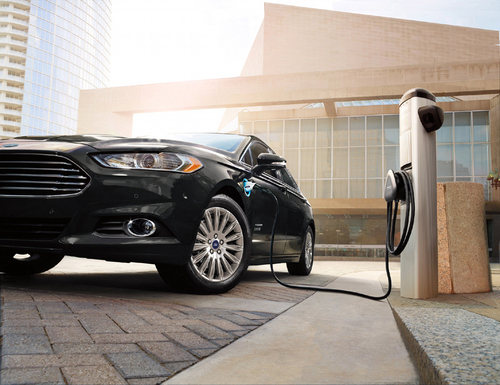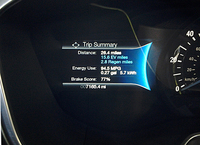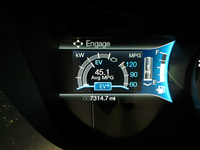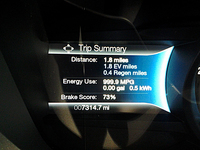2014 Ford Fusion Energi SE Review with 2015 Updates by Carey Russ
 2014 Ford Fusion Energi SE |
With the Ford Fusion Energi plug-in hybrid and a short commute, you could go for days between gasoline fill-ups
DRIVING DOWN THE ROAD WITH CAREY RUSS
• SEE ALSO: Ford Buyers Guide
 2014 Ford Fusion Energi SE |
With Ford products, the "Energi" badge means plug-in hybrid. Since the rationale behind a regular internal combustion - electric hybrid is a portable energy source for the electric motor to increase range over what would be possible given the current state of battery technology, and so independence from plugging in to an external power source, why would anyone want to plug in their hybrid?
 2014 Ford Fusion Energi SE |
To go further under electric power than would be possible with an equivalent regular hybrid, and possibly, given distance traveled and recharging availability and time, to go for days without using gasoline. There is a price for that. A larger battery pack, for longer electric (EV-mode) range means more lithium-ion cells. If you've even had to replace a laptop battery, you know that Li-ion batteries don't come cheap… The 2014 Fusion Energi has a considerable price premium over an equivalent Fusion Hybrid. Under the EPA test regimen, there is not a huge difference in fuel consumption, and EV-only range is between 15 and 21 miles, depending on driving. If your commute is in that range, or close, and you can recharge both at home and the office, you could go for quite a while without going near a gas station. And if you go a little further, no problem. Infernal combustion to the rescue, and the Energi works as a regular hybrid. Which means it'll still run in EV mode under low-load conditions just fine.
So this is not a mass-market car. The regular Fusion Hybrid, with a very reasonable price and good fuel economy, takes care of that niche. Plug-in hybrids are still early-adopter territory, and offer internal-combustion backup to EV operation and range. But given the rapid advances in battery technology, expect them to become increasingly mainstream in the near future. And as technology changes and perhaps battery prices drop, expect the price differential between regular and plug-in hybrids to decrease. MSRP for the 2015 Fusion Energi SE, available now, is listed as $34,700 as opposed to the $36,700 of my 2014 test car. Changes between the two are the usual colors and minor equipment changes. All functional parts are unchanged. So anything said about a 2014 model should be true for a 2015.
 2014 Ford Fusion Energi SE |
No functional changes to the Energi are required. How well does it work? While visiting friends on a warm -- 100ºF -- summer day, I demonstrated recharging. Plug the included 120V recharging pack and cable into a wall socket on one end and the SAE J1772 plug into the receptacle in front of the driver's-side front door. The battery was already partially-charged, so it took a couple of hours to top off. (Charging time from empty battery is 7 hours at 120V or 2.5 at a 240V charging station) Get in, turn on the air conditioning (100º!) and… cold air out the vents within 30 seconds, and a cool cabin quickly. This in EV mode. We then did a ten-mile drive, all under electric power, and had some EV range left at the end. I then drove home in regular hybrid mode, recharging the battery a bit with regenerative braking, and tried charging at home.
My house was built in 1943 and still has the original electrical system. Some other plug-in vehicles have refused to charge on grounds that there was no good ground. No such problem here, and six hours at 120V filled it. I'll find out what that cost when I get the next utility bill but I'm expecting not to notice much increase. If I was a plug-in owner, I'd install a 240V charging station in the garage.
Mileage will be of interest. Ford lists the Fusion Energi as getting 100 MPGe (electric equivalent of miles per gallon) or 43 mpg under gasoline power. My average for the tank was 45.1, a bit better than the 40 with a regular Fusion Hybrid earlier in the year. In EV mode, the display showed 999.9 mpg. In mixed-mode -- EV at slower speeds on surface streets, regular hybrid above that, it varied, with over 90 mpg at one point. As the warning goes, YMMV, and nowhere more so than with a vehicle like this.
APPEARANCE: Ford has, at times in the past, had some questionable styling. The current Fusion makes up for any previous idiosyncrasies. It proves that international elegance can work for a middle-class American sedan -- and if you doubt that, take a look at the Ford Mondeo sold in Europe. Same car! Obvious differences between the Energi and other Fusions? Badging and the charge port ahead of the driver's door. Like the Hybrid, the Energi has a near-complete undertray, all the better for reduced aerodynamic drag.
COMFORT: Inside, differences from an equivalent internal combustion-only Fusion are minimal. The major addition is the "EV Mode" switch on the console. Materials and fit and finish are first class, with textured soft-touch surfaces and multiple trim materials and textures. Front seat comfort is good, and the front seats are power-adjustable with three memory positions for the driver's seat. The leather-rimmed steering wheel adjusts manually for both tilt and reach and has controls for audio, phone, information, and cruise control systems. Interestingly, there is a regular key here -- only the Titanium gets pushbutton start/stop. The SE does have the beyond-fully featured SmartGuage® with EcoGuide programmable instrument system. Power system readouts and controls for various safety and convenience systems are to the left of the central speedometer, with audio, phone, and navigation information displayed to its right, plus the "Efficiency Leaves" that show how fuel-efficient your driving is. Need help? Just select from the tutorials. Main entertainment, navigation, phone, and climate system controls are through the central touch screen, with climate also by means of real controls below that.
No sunroof here, but the rear seat has good head and leg room for the size class, and a comfortable back angle. Unusually, but like the regular Fusion Hybrid, the rear seatback folds 60/40, although I suspect that is more for battery access than cargo as there is a five-inch space above the battery pack. And here the larger battery pack takes a toll on trunk space. The regular Fusion has 16 cubic feet of trunk space. The Hybrid has 12. The Energi has 8.2, and don't expect a spare tire.
SAFETY: The Fusion is a world car, so it has to meet worldwide safety standards. Which can be conflicting. So plenty of computer modeling took place before anything was built, and even more testing afterwards. Ford expected it to get the highest ratings for crashworthiness, and the Energi has five stars from NHTSA for front-seat side and rollover, which get four. Good road manners and fine antilock four-wheel disc brakes with the AdvanceTrac stability enhancement system help drivers to avoid accidents.
RIDE AND HANDLING: The Energi weighs around 250 pounds more than the regular Fusion Hybrid. It uses the same fully-independent MacPherson strut / multilink suspension, but here the springs and shocks are tuned more softly, but correctly matched so there is none of the float and wallow that were part of the American car driving experience in the now thankfully-distant past. Ride quality is best describes at "contemporary luxury", emphasizing comfort but allowing good control. Which is perfect for the Energi's mission. Luxury implies quiet, and especially in EV mode, it's very quiet inside.
PERFORMANCE: More weight, same basic drivetrain -- with larger battery pack -- than the regular Hybrid. So no surprise that the Energi is a little slower in acceleration, by maybe a second or less to 60 mph. Still, it's up to any task in traffic, and can allegedly cruise at speeds up to 85 mph in EV mode. I never got over 75 in EV, and yes it's starting to run out of go there. But at the other end of the speed range, careful throttle modulation was necessary in my slippery driveway as an electric motor makes maximum torque as soon as it starts to rotate, and EV mode or not, the Energi is likely to operate electrically at low speeds unless the battery is nearly completely exhausted. As in the Hybrid, power from a 2.0-liter Atkinson-cycle four-cylinder gasoline engine with 141 horsepower (at 6000 rpm) and 129 lb-ft of torque (at 4000 rpm) and a 118-hp permanent-magnet synchronous AC traction motor is seamlessly blended via a computer-managed continuously-variable transmission (CVT). Maximum combined horsepower is 188; since an electric motor makes its maximum torque as soon as it begins to rotate, the motor's 177 lb-ft makes itself felt when it's needed. Throttle response is linear, and except when the engine is under heavy throttle, it's very hard to tell what combination of power is moving the car at any given time without glancing at the power display or the "EV" light. The major difference between the Hybrid and Energi is the latter's larger battery pack and plug-in recharging ability
CONCLUSIONS: With the Ford Fusion Energi plug-in hybrid and a short commute, you could go for days between gasoline fill-ups, and even strategically using the engine it's possible to get amazing mileage. And if there is no charging station, no problem -- it still works like a regular hybrid.
SPECIFICATIONS
2014 Ford Fusion Energi SE
Base Price $ 38,700
Price As Tested $ 40,585
Engine Type Atkinson-cycle DOHC inline 4-cylinder with independently-variable cam phasing
Engine Size 2.0 liters / 122 cu. in.
Horsepower 141 @ 6000 rpm
Torque (lb-ft) 129 @ 4000 rpm
Motor Type Permanent magnet AC synchronous
Horsepower 118 @ 6000
Torque (lb-ft) 117 @ 0 rpm
Total system horsepower (sustained) 188
Transmission electronically-managed continuously-variable
Wheelbase / Length 112.2 in. / 191.8 in.
Curb Weight 3913 lbs.
Pounds Per Horsepower 20.8
Fuel Capacity 14 gal.
Fuel Requirement 87 octane unleaded regular gasoline
Tires P225/50 R17 93V Michelin X Green Energy Saver A/S m+s
Brakes, front/rear vented disc / solid disc with ABS and ESC plus regenerative braking
Suspension, front/rear independent MacPherson strut / independent multilink
Drivetrain transverse front engine and motor, front-wheel drive
PERFORMANCE
EPA Fuel Economy - miles per gallon city / highway / observed n/a / n/a / 45 (hybrid average)
0 to 60 mph est 9.5 sec
OPTIONS AND CHARGES
Reverse Sensing System $ 295
Navigation System $ 795
Destination and Delivery $ 795


